|
These web pages have been constructed by
Professor
Louise Ripley to parallel the readings in the
Canadian edition of the Armstrong, Kotler et. al. text Marketing:
An Introduction. (Note now as you start the course: you should
know the authors of your textbook: it is important to know whose
view of Marketing you are studying. I always ask you on the test). These web pages clarify
difficult terms and provide you with additional views on some of
the topics covered. The Learning Units each contain a number of
Waving Hand
Exercises to aid your learning;
You will be posting your answers to each Waving Hand Exercise in
Moodle. Note that the
Exercise contains the word "Moodle" which, if you click on
it, will take you to Moodle. The web pages are up to date
with the newest, 5th, edition, but you can use them with the
fourth as well.
Some of the
Waving Hand exercises offer you opportunities to explore Marketing concepts
in one of the largest laboratories you'll ever find in any course
- the "real world" of shopping and buying, where you can try
applying the theories you're reading. Some of them ask you just to
think about what you would do in certain situations. Some of them
ask you to apply concepts you are learning to the Marketing Plan
product you are working on (this is provided to encourage you to
get working early on your Final Exam Substitute group project). Work with these pages as you read the chapters.
 |
*Exercise
Testing the System |
Practice sending a message. Think about something you like
or dislike about Marketing: perhaps a favourite ad and
why you like it, or a retail store that drives you
crazy because they... do what? What don't you like
about Marketing? Post your answer in the
Moodle Discussion Group. |
|
*I. What Is Marketing?
How
Five Different Marketing Scholars Have Seen Marketing
One of the things you get to do when you become a big name in a
scientific field is to create your own model of how you see the
field in which you work. Five major names in Marketing you should
know are Hunt, Borden, Levitt, Bagozzi, and Arndt.
(note: It is important to know about the scholars who shape the
field you are studying; I always ask about these on the test, and
I always ask the name of the authors of your textbook)
Hunt's Three Dichotomies Model Shelby Hunt maintains that ANY Marketing question will fit into one of these
8 cells. While reading for this course, keep Hunt's model in mind
and see if you find any
marketing questions that do NOT fit. Hunt has a reasonably broad
view of Marketing, meaning that its study covers a lot of areas.
| |
Positive |
Normative |
| |
Micro |
Macro |
Micro |
Macro |
| Profit
|
e.g.: How does Walmart set prices? |
Do the poor pay more? |
How should Walmart set
prices? |
Should the poor pay more? |
Not-for-Profit

Art Gallery of Ontario |
|
How does the AGO set prices? |
Do TV ads affect elections? |
How should the AGO set
prices? |
Should politicians be sold
like toothpaste? |
|
A dichotomy
is just an academic word for two-way split. Male/female is a dichotomy.
Yes/No is a
dichotomy. In-House/Outside Agency is the dichotomy on
which I did a logistic regression analysis for my doctoral thesis
in advertising strategy (I often referred to it privately as the Inhouse/Outhouse
question). |
|
The term Profit/Not-for-Profit
should be self-evident. How do you start a non-profit business in the
technology sector today? Start one and
wait. That not-so-funny joke is representative of why we
now use the term not-for-profit - it implies a
certain deliberate intent. |
|
The Positive/Normative
dichotomy deals with whether we're talking about how things are
(positive) or how they should be (normative). A positive
statement tells how something works (we
replace the stock on our shelves at the end of each day). A normative
statement says how you
think things should be done (we ought to institute a just-in-time
inventory policy).
Note: Ethical
questions are ALWAYS normative.
|
| The Micro/Macro
dichotomy as used in Hunt's model refers to things that happen
within the firm and affect the firm in its everyday operations
versus things that the firm does that relate to the larger
environment, to society. A micro (normative) question for the tobacco
companies would be how much it ought to spend to have the printing
done on their cigarette cartons. A macro (normative) question would be whether
they should get rid of the Joe Camel ads when research shows an
overwhelming increase in the number of young teens smoking Camels
after Joe arrived in the magazines. This micro/macro dilemma, the
conflict between what is good for the firm and what is
good for society, is a very old question. In the 1950's,
Thorstein Veblen wrote a book exposing the fact that in
poverty-stricken areas of large cities, poor people often
pay more for their basic food necessities because stores
know they can't afford to drive elsewhere.
|
 |
Exercise
Dichotomies |
Test
yourself with the
sample questions (and answers) about Hunt's Model on the
Test Policy Page
Reactions?
Post your answer in the
Moodle Discussion Group. |
|
Borden's Four P's
Model
|
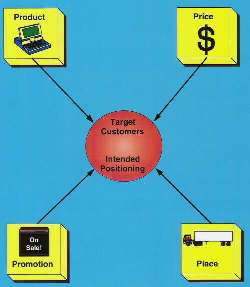
|
We know now that Marketing is far more
complicated that just those 4 P's and how they relate to
customer and intended positioning, but at the time (1959)
it was a pretty revolutionary idea. Neil H. Borden first put it
into formal words in his presidential speech to the American
Marketing Association.
|
|
Levitt
on Marketing
Myopia |
 |
Levitt, Theodore (1975) "Marketing
Myopia" Harvard Business Review
(September-October):26-48. |
|
Theodore Levitt's article, now more than
forty-five years old, is
still relevant today. Myopia means short-sightedness and Levitt claims most failures of firms are due to short-sighted lack of vision in top management. His view of marketing is long-range vision, anticipation of change, and planning for the future. There are numbers of companies and whole industries that
went bankrupt or nearly failed due to lack of vision.
The railroads thought they were in the railroad business instead of the transportation business and failed to adapt when airplanes came in. Hollywood film companies nearly went broke before they realized they weren't in the film business,
but the entertainment business. Now you can rent a video about a month after the film comes
out because they've changed from being in the business of producing movies for the theatre to
being in the business of providing entertainment that meets
our needs. Early grocery stores refused to recognize the popularity of the large
supermarkets until it was too late. They said people would never give up the small personal Mom-and-Pop store for a cold anonymous super-store. But it happened.
Interestingly, today, many people with hectic life styles are returning to small stores with personal attention where the shopkeepers know you. Things are always changing, and the good marketer needs
the vision to be on top of changes and trends.
At the heart of this is the need to think creatively as a
marketer. A marketer needs to know theories and terminology
and the way that things work, but s/he also needs to be able
to think outside the box.
|
 |
Exercise
Marketing Myopia |
From
your own experience as a consumer, name a product that
you buy now that you think could not ever be replaced by
another product in the future.
NOTE: This is not about what you personally like and can't
live without; it means some product (good or service) for which you believe there would
be absolutely NO substitute, ever); explain your choice
briefly.
Post
your answer in the
Moodle Discussion Group. |
to Definitions of Marketing |
| Bagozzi
- Marketing as Exchange Richard Bagozzi
has perhaps the broadest view of Marketing of any of our top
scholars in the field. He contends that ANY exchange is
Marketing, whether it is the exchange of money for a bar of
soap or the exchange of a drink for consideration of a sales
pitch, or exchange of quitting smoking for a healthier life.
|
Arndt
- Needs, Wants, and Demands
The main role of the marketer is to move the consumer from need to want
to demand
| Specificity
Level |
Matching
Field |
Influencing
Factors |
| |
Supply |
Demand |
|
| High |
Brand |
DEMAND |
Competition |
| Medium |
Product Class |
WANT |
Social,
Consumer Resources |
| Low |
Product Group |
NEED |
Personality,
Culture |
 |
While Bagozzi
sees Marketing very broadly,
Johan Arndt has a much narrower view of what we do as marketers. Arndt
says that marketers must concentrate on
doing what we do best, which is matching supply and demand. He
claimed that the role of the marketer is to move the consumer from
need to want to demand. As a consumer, you start in a position of
need -
very basic, not very specific, influenced
mainly by personality and cultural factors, looking at product
group only such as something to keep your teeth clean, maybe baking
soda. |
 |
Arndt sees the marketer moving you up
into a stage of more specific wants, influenced by what you can afford
and what society expects, where you begin to think about a product class - you
want toothpaste;
any brand will do, what's on sale this week? |
 |
And finally Arndt's marketer
moves you
up to the state of demand, influenced by competition, where you
walk into the drugstore and purchase a tube
of a specific brand of toothpaste. The influencing factors are
cumulative. Personality and culture continue to influence us
at the level of wants and demands, as well as needs. |
These theories and terms aren't just academic
games for professors who have nothing better to do. Real-life
marketers use them; we just put a name to it so we can be more
precise and speak a
common language when discussing issues. There is a
clothing store on Avenue Road in Toronto called simply,
"Wants". A recent ad for a
cigarette whose target market is women, says, "When it comes to clothes,
want and need mean exactly the same thing." Consider
what is the difference between a need and a want.
 |
Exercise
Need/Want |
If they
meant exactly the same thing, they wouldn't be two
different words. What is the difference between NEED and
WANT?
Post
your answer in the
Moodle Discussion Group. |
|
Marketing
Defined
 |
Exercise
Definitions |
Look at
the ads/pictures below and how they illustrate the different
definitions of Marketing. Which definition best fits your own idea of
what Marketing is?
Post your answer in the
Moodle Discussion Group. |
|
American Marketing Association
 |
The process of planning and executing the conception, pricing,
promotion and distribution of ideas, goods, and services to create
exchanges that satisfy individual and organizational objectives |
| What idea is being promoted
in this old ad, and to whom? What objectives does it fulfill
and for what organization? What pricing is involved? |
Malcolm McNair
 |
The
creation and delivery of a standard of living
|
Think about and respect the need for
creativity in Marketing that this definition requires!
What new standard of living
is being promoted in this ad?
What creative thinking
preceded the invention of the airplane, or of any product?
What new wants and demands arose from the introduction of
the airplane? |
Philip Kotler in a Marketing
Article
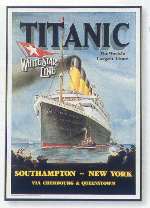 |
Getting the
right goods and services to the right people at the right place at
the right time at the right price with the right communication and
promotion |
| Many people thought this
infamous trip was the right idea. Why
did they go? What services and experiences were they
seeking? What value and satisfaction did they feel they
got for their money? (BEFORE the ship hit the iceberg!) |
Armstrong/Kotler (in your
textbook)
 |
A social and managerial
process by which individuals and groups obtain what they
need and want through creating and exchanging products and
value with others |
| Think about the number of
Canadian dollars that go south every spring, including
your professor shown here with her dog Amber. We brought her
to Myrtle Beach several Spring Breaks, after I'd been there
for academic conferences and thought it would be a nice
place to go in mid March.
What exchange or transaction is going on
here between the professor and the city? What relationship developed?
|
In Fifteen Words (Professor Lee Li,
York University)
|
Marketing colleague Professor Lee Li, tells his students
that if you truly understand a subject, you should be able
to describe it in about 15 words.
Try these for
Marketing:
|
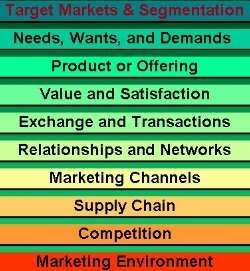 |
 |
Exercise
What is Marketing? |
In
your own words, now as you start the course, what do
you think Marketing is?
Post your answer in
the
Moodle Discussion Group. |
|
The Marketing Process
•Understand
the marketplace and customer needs and wants.
•Design
a customer-driven marketing strategy.
•Construct
a marketing program that delivers superior value.
•Build
profitable relationships and create customer delight.
•Capture
value from customers to create profits and customer
equity.
|
II. Understanding the
Marketplace and Customer Needs
Needs, Wants, and Demands
Check out what a summer Consumer Behaviour class
had to say about Needs and
Wants in a rap song.
Marketing Offers - Products, Services, and
Experiences
A product is anything that can be offered to a
market to satisfy a need or want. It may be a good such as a nail which is
a physical tangible piece of stuff that you can hold. It may be a service, like a
haircut which is intangible and ephemeral. It may be a mixture of
the two as when a restaurant provides you with food (tangible) and
service - the chef cooks your chateaubriand and the waiter brings
it to your table, accompanied by wine steward, maitre d'hotel,
depending on how fancy you want to get.
Be sure not to get caught up in the traditional trap of
referring to "products and services." Services are products too.
Refer instead to "goods and services."
Look now at the Product
Class and begin to think about what product you will work
with.
 |
Exercise:
Plan
Kind
of Product |
Look at
the suggested
Product Classes for your Marketing Plan, and list one example each of a good,
a service, and an experience that would fit in one of
those classes.
Post your answer in the
Moodle Discussion Group. |
|
Value and Satisfaction
Perception is the key word here. A satisfied
customer is one who perceives your product to be of value and to
have satisfied the need felt.
Exchange, Transactions, and
Relationships
| Remembering Bagozzi
who contends that ANY exchange is Marketing:
What made the
other side of the road enticing enough to lure the chicken
over? A Far Side cartoon maintained it was
"Marketing."
Everything is marketing and marketing is everything (Ripley's interpretation of
Bagozzi) |
 |
 |
Exercise
Exchange |
Describe
three different "exchanges" you experienced in
registering for and beginning this course.
Post your answer in the
Moodle Discussion Group.
|
|
Markets A
market is simply the entire set of people or organizations who
might or will buy or obtain your product offering. We will
investigate this concept in depth when we examine Market Targeting
in the unit on segmentation. Long before that, you will be asked
to begin to decide on a market for your product in the Marketing
Plan assignment
III. Designing a Customer-Driven
Marketing Strategy
Selecting Customers to Serve
As a marketer, you're not always trying to
increase demand. Some marketing jobs involve de-marketing,
or reducing demand for a
particular product or service.
 |
Exercise
Demand
Management |
Name some products in your
own experience for which the marketer has good reason to want you
to consume LESS.
Post your answer in the
Moodle Discussion Group. |
|
Choosing a Value Proposition
How will the company differentiate itself
from its competitors? This will be important in your Marketing
Plan project. You will want to find a way to be significantly
different from others who sell similar products to yours.
Marketing Management Orientations
Production Concept
When demand is high, keep
producing enough of the item to reduce the cost of
producing it. Sometimes this approach is effective, and
even today some things are most effectively marketed this
way (but generally it's not a good way to sell something)
 |
Henry
Ford said of his early automobile that people could have
it in any colour they wanted as long as it was black.
|
 |
Exercise
Henry Ford |
Why
was Ford able to make this
statement?
Post your answer in
the
Moodle Discussion Group. |
|
 |
Texas
Instruments brought down the price of the calculator
and made it accessible to the ordinary person. When
I worked in Finance in Chicago in the 1970's,
calculators were only on the desks and private hands
of chartered accountants. When I started my MBA
programme in 1972, calculators began to be available
but they were too expensive (I earned $500/month; a
calculator that did 4 functions cost $150).
They soon dropped in price to $79,
at which point I bought one. It was huge and did only 4
functions. Recently I received one free to encourage me to
use my store account; it was the size of a credit
card,
solar powered, and also did percent, square root, and
logarithms.
|
 |
Exercise
Production
Concept |
Think of
a product sold today that sells well mainly because it is
inexpensive and there are lots of them everywhere.
Post your answer in the
Moodle Discussion Group. |
|
Product Concept
| Defining your business by the
product you sell rather than by what your customer needs is the
classic "Better Mousetrap" trap. Just because you build
it does NOT mean they will come. |

Field of Dreams
|
 |
Exercise
Product Concept |
It was
Ralph Waldo Emerson who first popularized the saying,
"Build a better mousetrap and the world will beat a
path to your door." What do you buy simply because it is an excellent
product, a product that that needed no marketing to get you out to buy
it .
Post your answer in the
Moodle Discussion Group.
|
|
Selling Concept
 |
Some things still
have to be sold.
There's an insurance company ad
that maintains that most people would rather deal
with bugs than with life insurance.
|
Marketing Concept
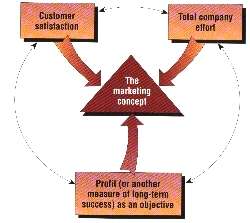 |
The basis of marketing
in the sixties through the 1980's, this model of three
cornerstones is still a cornerstone itself in marketing
management theory, although we now put more
emphasis on customer, competition and other
factors. The idea is a simple one -- the whole firm works
together to meet the needs of the consumer, at a profit to
the firm. Remember this concept - it will show up
often. |
 |
Exercise
Marketing Concept |
Think
about your shampoo. What does the company that makes it
do to meet your needs? In what ways do you think that
company all works together as a team to produce a good
shampoo? What ensures a profit?
Post your answer in the
Moodle Discussion Group. |
|
| Marketing
Plan Hint - You will need to
consider the concept of thinking first of your customer's needs
when planning your Marketing Plan product. A link in your
Marketing
Plan Assignment sends you here when you get to that
part. |
Societal Marketing Concept
| |
Marketing today includes the obligation to
practice sustainable marketing and to examine
societal
issues, and there are many, including the fact
that the fastest growing market for cigarettes is 12
year-old girls |
| Then
there's the marketing of war |
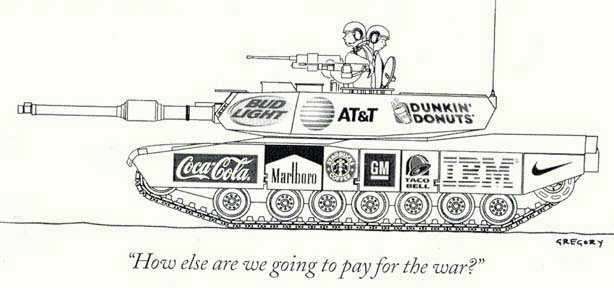 |
 |
Exercise
Societal Marketing Concept |
Give an
example of a product you yourself purchase which
involves a conflict between consumer's short-term wants
and their long-run welfare (e.g. for cigarettes: short
term want - satisfy craving; long-term welfare - your
good looks (when you're 50, your face is going to look
like an old shoe).
Post your answer in the
Moodle Discussion Group. |
|
| IV. Preparing a Marketing Plan
and Programme
Take a few minutes now to look at the
Marketing Plan in Unit 12
|
V. Building
Customer Relationships
|
The Changing Nature of Customer Relationship
Connecting with
fewer but more profitable customers |
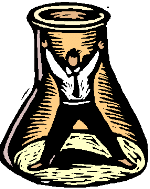 |
 |
Exercise
Relationship Marketing |
Describe
a relationship you have with someone who markets a good
or service you buy. Why do you have this relationship? What caused it? What
keeps it going?
Post your answer in the
Moodle Discussion Group. |
|
My most recent
relationship marketing story is about something called "the
gear ring". I saw it advertised in a magazine and, having
often been told that I think like an engineer, and having
fallen in love with the little working gears, I bought one
online. If you ever buy something online that has to be
sized, like a ring, i hope you find a company as sympathetic
and helpful as Kinekt. Throughout the process they made me feel as if
I'd known them personally for years and that of course
they'd keep trying until we got a ring that fit. If you see
me at a meeting on campus you'll probably see me fiddling
with something, a beautiful little thing made of stainless
steel with gears that work to turn the edges. It comes with
a warning notice:
|
 |
Warning: The spinning of
this ring may inadvertently cause a lack of productivity and
work-related progress. Please enjoy responsibly.
|
|
| Another
relationship story is my former Ford
dealer, Freeway Ford. I
bought my beloved purple Taurus there in 1992 and they
looked after it for 12 more years. One bitter cold Friday
evening at 5 pm the guys at the gas station I'd stopped
at dropped and lost the oil cap for my engine. After
twenty minutes in the cold while they unsuccessfully
nattered about trying to figure out what to do, I called
my Ford dealer
and asked if they could bring me an oil cap. Within ten
minutes, Dan was there with a cap he'd charged to his
own account, said I could come by the next day and pay for
it. Freeway Ford is no longer there but now I get
excellent service for my Mazda Miata at Agincourt Mazda. |

 |
|
A little further from home is
Tom Natvig in Sweden, a wood technologist who runs the one-man business that
sells the wonderful little Ear Bag (If you see me in
person outdoors between October and May I'm likely to have
them on). This is a side business from his regular work as
a certified engineer in in the forest industry, a rather
rare occupation that has taken him to 27 countries in his
career including Ethiopia, Guinea Bissau, and Sri Lanka.
It was in the freezing cold of the 1994 winter Olympics in
Norway that he came up with the idea for the ear bag. His is the first site from
which I ever ordered anything on the Internet, and he is a
true example of what customer service is all about. Check
it out at Earbags. |
 |
| Partnership Relationship Marketing |
Connections
with Marketing Partners
Supply Chain
Management
Strategic Alliances |
 |
•Working with partners in other company
departments and outside the company to jointly bring
greater value to the customers.
–Every department in an organization contributes to
customer satisfaction.
–Suppliers are carefully controlled through supply
chain management.
–Strategic alliances create new opportunities to
delight customers.
|
VI. Capturing Value From
Customers
|
Creating Customer Loyalty and
Retention - We need to
consider the value of all purchases over a consumer's
lifetime, not just what they're buying today |
Growing Share of Customer
- Percentage of customers who buy your product out of all
customers who buy in the product category
Companies strive to increase share of customer
Grow share of customer by creating brand extensions |
Building Customer Equity
- Combined customer lifetime value of all of a company's
customers
This measure is often a more accurate measure than sales or
market share
It is a combination of marketing share, share of customer, and
lifetime customer value |
VII. The Changing Marketing
Landscape
The Changing Economic Environment
Since 2008, everyone
is tightening the purse strings and finding
ways to save money. We're also looking for
more sensible consumption.
|
 |
The Digital Age
has transformed the way we do
marketing and the way we live our
lives.
|
 |
The Growth of Not-for-Profit Marketing
Using Marketing
techniques to promote good causes is a
growing concern |
 |
Rapid Globalization
Connecting with
fewer but more profitable customers |
 |
Sustainable Marketing:
The Call for More Social
Responsibility
Developing a
conscience about Marketing
Extending Marketing to more than just
consumer goods firms. The copy on this
"quit smoking" campaign ad says,
"Having A little trouble quitting smoking?" |
 |
 |
Exercise
Connections |
Which of these
areas interests you most? Where might you like to work
in Marketing in one of these growing areas? What would
you like to do?
Post your answer in the
Moodle Discussion Group.
|
|
VIII. So What Is Marketing?
Pulling It All Together
 |
Exercise
What is Marketing? |
What do you think
Marketing is all about?
Post your answer in the
Moodle Discussion Group.
|
|
IX. The Marketing Area
Take this moment as you start the course to learn a little about
the Marketing Area of the School of Administrative Studies. It
is a presentation we put together for a SAS retreat on the topic
of Research. It was done very much to emphasize the fact that so
many people think Marketing is all about glitz and glamour and
colour and light and sound - all of these things being, of
course, important in a good Marketing presentation, but not
perhaps to the extent they are deliberately used here! In this,
you will find a brief serious description of some of the
research interests of all the colleagues in Marketing.
The Marketing Area of the School
of Administrative Studies
|